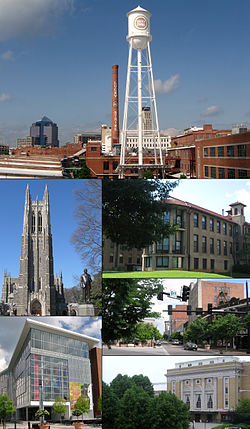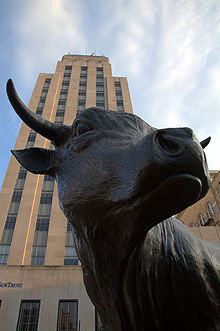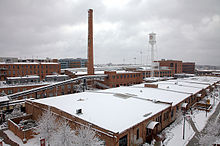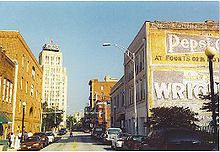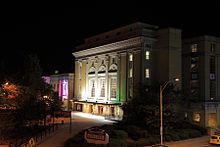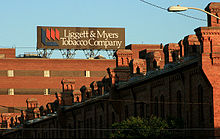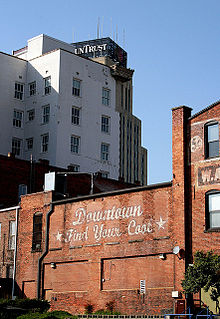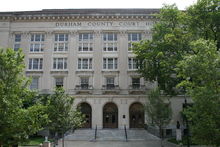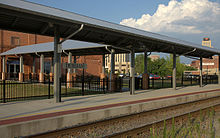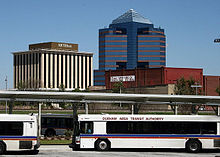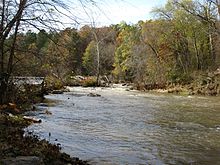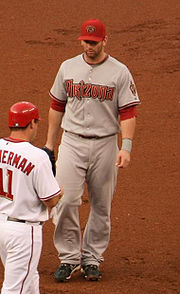- Durham, North Carolina
-
Durham, North Carolina — City — Clockwise from top: Durham skyline, North Carolina School of Science and Mathematics, Five Points, Carolina Theater, Durham Performing Arts Center, Duke Chapel 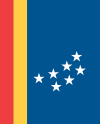
FlagNickname(s): "Bull City", "City of Medicine"[1] Location within the state of North Carolina Coordinates: 35°59′19″N 78°54′26″W / 35.98861°N 78.90722°WCoordinates: 35°59′19″N 78°54′26″W / 35.98861°N 78.90722°W Country United States State North Carolina Counties Durham, Wake[2] Incorporated April 10, 1869[3] Named for Bartlett S. Durham Government – Type Council-Manager – Mayor Bill Bell – City Manager Tom Bonfield Area – Total 94.9 sq mi (245.8 km2) – Land 94.6 sq mi (245.1 km2) – Water 0.3 sq mi (0.7 km2) Elevation 404 ft (123 m) Population 228,330 – Demonym Durhamite Time zone EST (UTC-5) – Summer (DST) EDT (UTC-4) ZIP codes 27701, 27702, 27703, 27704, 27705, 27706, 27707, 27708, 27709, 27710, 27711, 27712, 27713, 27715, 27717, 27722 Area code(s) 919 Twin Cities – Arusha  Tanzania
Tanzania– Durham  United Kingdom
United Kingdom– Kostroma  Russia
Russia– Toyama  Japan
JapanFIPS code 37-19000[4] GNIS feature ID 1020059[5] Website Durham city official site Durham is a city in the U.S. state of North Carolina. It is the county seat of Durham County[6] and also extends into Wake County.[2] It is the fifth-largest city in the state, and the 85th-largest in the United States by population, with 228,330 residents as of the 2010 United States census.[2] It is the home of Duke University and North Carolina Central University, and is also one of the vertices of the Research Triangle area (home of the Research Triangle Park).[7]
In 2003, the previous Raleigh-Durham-Chapel Hill metropolitan statistical area (MSA) was re-defined by the U.S. Office of Management and Budget, resulting in the formation of the Raleigh-Cary, NC MSA and the Durham, NC MSA.
Durham is the core of the four-county Durham-Chapel Hill MSA, which has a population of 504,357 as of Census 2010. The US Office of Management and Budget also includes Durham as a part of the Raleigh-Durham-Cary Combined Statistical Area, which has a population of 1,749,525 as of Census 2010. Effective June 6, 2003 the Office of Management and Budget redefined the Federal Statistical Areas and dismantled what had been for decades the Raleigh-Durham-Chapel Hill, MSA and split them into two separate MSAs even though the region still functions as a single metropolitan area.
Contents
History
Pre-establishment
The Eno and the Occaneechi, related to the Sioux, and the Shakori lived and farmed in the area which became Durham. They may have established a village named Adshusheer on the site. The Great Indian Trading Path has been traced through Durham, and Native Americans helped to mold the area by establishing settlements and commercial transportation routes.
In 1701, Durham's beauty was chronicled by the English explorer John Lawson, who called the area "the flower of the Carolinas." During the mid-1700s, Scots, Irish, and English colonists settled on land granted to John Carteret, Earl of Granville, by King Charles I (for whom the Carolinas are named). Early settlers built gristmills, such as West Point, and worked the land.
Prior to the American Revolution, frontiersmen in what is now Durham were involved in the Regulator movement. According to legend, Loyalist militia cut Cornwallis Road through this area in 1771 to quell the rebellion. Later, William Johnston, a local shopkeeper and farmer, made Revolutionaries’ munitions, served in the Provincial Capital Congress in 1775, and helped underwrite Daniel Boone's westward explorations.
Large plantations, Hardscrabble, Cameron, and Leigh among them, were established in the antebellum period. By 1860, Stagville Plantation lay at the center of one of the largest plantation holdings in the South. African slaves were brought to labor on these farms and plantations, and slave quarters became the hearth of distinctively Southern cultural traditions involving crafts, social relations, life rituals, music, and dance. There were free African-Americans in the area as well, including several who fought in the Revolutionary War.
Antebellum and Civil War
Prior to the arrival of the railroad, the area now known as Durham was the eastern part of present-day Orange County and was almost entirely agricultural, with a few businesses catering to travelers (particularly livestock drivers) along the Hillsborough Road. This road, eventually followed by US Route 70, was the major east-west route in North Carolina from colonial times until the construction of interstate highways. Steady population growth and an intersection with the road connecting Roxboro and Fayetteville made the area near this site suitable for a US Post Office, which was established in 1827. (Roxboro, Fayetteville and Hillsborough Roads remain major thoroughfares in Durham, although they no longer exactly follow their early 19th century rights-of-way.)
Durham's location is a result of the needs of the 19th century railroad industry. The wood-burning steam locomotives of the time had to stop frequently for wood and water and the new North Carolina Railroad needed a depot between the settled towns of Raleigh and Hillsborough. The residents of what is now downtown Durham thought their businesses catering to livestock drivers had a better future than a new-fangled nonsense like a railroad and refused to sell or lease land for a depot. Eventually a railway depot was established on land donated by Bartlett S. Durham in 1849.
Durham's Station, as it was known for its first 20 years, was just another depot for the occasional passenger or express package until early April 1865 when a Federal Army commanded by William T. Sherman occupied the nearby state capitol of Raleigh during the American Civil War. The last intact Confederate Army, commanded by General Joseph E. Johnston, was headquartered in Greensboro 50 miles (80 km) to the west. After the surrender of the Army of Northern Virginia by Robert E. Lee at Appomattox, Virginia, General Johnston sought surrender terms, which were negotiated at Bennett's Place, a farm halfway between the lines about 3 miles (4.8 km) west of Durham's Station. While what could have easily been a battle in Durham was averted, the wholesale looting of houses in the Durham area by Union cavalry, in what people thought was a truce period, led to a bitterness towards Republicans and the North that lasted well into the 20th century.
Fortunately for Durham, its future had nothing to do with 19th century politics. Thousands of soldiers, both Union and Confederate, were encamped near Bennett Place They confiscated the area's Brightleaf Tobacco, which had a milder flavor than other tobacco varieties. Durham's tobacco was far more pleasant to smoke or chew than any tobacco they had ever had and when they returned home and couldn't get anything like it, they started sending letters to Durham to get more.
Reconstruction and the rise of Durham tobacco
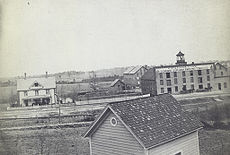 Early view of first Duke tobacco factory and family home, Durham, 1883
Early view of first Duke tobacco factory and family home, Durham, 1883
The community of Durham Station grew slowly before the Civil War, but expanded rapidly following the war, with much of this growth attributed to the establishment of a thriving tobacco industry. Veterans returned home after the war with an interest in acquiring more of the great tobacco they had sampled in North Carolina. Numerous orders were mailed to John Ruffin Green's tobacco company requesting more of the Durham tobacco. W.T. Blackwell partnered with Green and renamed the company as the "Bull Durham Tobacco Factory". The name "Bull Durham" is said to have been taken from the bull on the British Colman's Mustard, which Mr. Blackwell (mistakenly) believed was manufactured in Durham, England. Mustard, known as Durham Mustard, was originally produced in Durham, England, by Mrs Clements and later by Ainsley during the eighteenth century. However, production of the original Durham Mustard has now been passed into the hands of Colman's of Norwich, England.
Incorporation
As Durham Station's population rapidly increased, the station became a town and was incorporated by act of the North Carolina General Assembly, on April 10, 1869. It was named for the man who provided the land on which the station was built, Dr. Durham. At the time of its incorporation by the General Assembly, Durham was located in Orange County. The increase in business activity, land transfers etc, made the day long trip back and forth to the county seat in Hillsborough untenable, so twelve years later, on April 17, 1881, a bill for the establishment of Durham County was ratified by the General Assembly, having been introduced by Caleb B.Green, creating Durham County from the eastern portion of Orange County and the western portion of Wake County. In 1911, parts of Cedar Fork Township of Wake County was transferred to Durham County and became Carr Township.[3]
Early growth (1900–1970)
The rapid growth and prosperity of the Bull Durham Tobacco Company, and Washington Duke's W. Duke & Sons Tobacco Company, resulted in the rapid growth of the city of Durham. Washington Duke was a good businessman, but his sons were brilliant and established what amounted to a monopoly of the smoking and chewing tobacco business in the United States by 1900. In the early 1910s, the Federal Government forced a breakup of the Duke's business under the antitrust laws. The Dukes retained what became known as American Tobacco, a major corporation in its own right, with manufacturing based in Durham, and whose advertisements on radio in the 1930s and 1940s and television in the 1950s and 1960s were as ubiquitous as those of Coca-Cola or McDonald's today.
Prevented from further investment in the tobacco industry, the Dukes turned to the then new industry of electric power generation, which they had been investing in since the early 1890s. Duke Power (now Duke Energy) brought in electricity from hydroelectric dams in the mountains through the newly-invented technology of high voltage power lines. At this time (1910–1920), the few towns and cities in North Carolina that had electricity depended on local "powerhouses". These were large, noisy, and smoky coal-fired plants located next to the railroad tracks. Duke Power quickly took over the electricity franchises in these towns and then electrified all the other towns of central and western North Carolina, making even more money than they ever made from tobacco. Duke Power also had a significant business in local franchises for public transit (buses and trolleys) before local government took over this responsibility in the mid to late 20th century.
The success of the tobacco industry in the late 19th and early 20th century encouraged the then-growing textile industry to locate just outside of Durham. The early electrification of Durham was also a large incentive. Drawing a labor force from the economic demise of single family farms in the region at the time, these textile mills doubled the population of Durham. These areas were known as East Durham and West Durham until they were eventually annexed by the City of Durham.
Much of the early city architecture, both commercial and residential, dates from the period of 1890–1930.
Durham quickly developed a vibrant Black community, the center of which was an area known as [Hayti,_Durham,_North_Carolina] (pronounced HAY-tie), just south of the center of town, where some of the most prominent and successful black-owned businesses in the country during the early 20th century were established. These businesses — the best known of which are North Carolina Mutual Insurance Company and Mechanics & Farmers' Bank — were centered on Parrish St., which would come to be known as "Black Wall Street." In 1910, Dr. James E. Shepard founded North Carolina Central University, the nation's first publicly supported liberal arts college for African-Americans.
In 1924, James Buchanan Duke established a philanthropic foundation in honor of his father Washington Duke to support Trinity College in Durham. The college changed its name to Duke University and built a large campus and hospital a mile west of Trinity College (the original site of Trinity College is now known as the Duke East Campus).
Durham's manufacturing fortunes declined during the mid-20th century. Textile mills began to close during the 1930s. Competition from other tobacco companies (as well as a decrease in smoking after the 1960s) reduced revenues from Durham's tobacco industry.
In a far-sighted move in the late 1950s, Duke University, along with the University of North Carolina in Chapel Hill and North Carolina State University in Raleigh, persuaded the North Carolina Legislature to purchase a large tract of sparsely settled land in southern Durham County and create the nation's first "science park" for industry. Cheap land and a steady supply of trained workers from the local universities made the Research Triangle Park an enormous success which, along with the expansion resulting from the clinical and scientific advances of Duke Medical Center and Duke University, more than made up for the decline of Durham's tobacco and textile industries.
Civil Rights
As a result of its substantial African-American community, a prominent Civil Rights movement developed in Durham. Multiple sit-ins were held, and Martin Luther King, Jr., visited the city during the struggle for equal rights. The Durham Committee on the Affairs of Black People, organized in 1935 by C.C. Spaulding and James E. Shepard, has been cited nationally for its role in the sit-in movements of the 1950s–60s. The committee also has used its voting strength to pursue social and economic rights for African-Americans and other ethnic groups. In the late 1950s, Douglas E. Moore, minister of Durham's Asbury Temple Methodist Church, along with other religious and community leaders, pioneered sit-ins throughout North Carolina to protest discrimination at lunch counters that served only whites.
Widely credited as the first sit-in of the Civil Rights Movement, on June 23, 1957, Moore and six others assembled at the church to plan the protest. The young African Americans moved over to the segregated Royal Ice Cream Parlor and took up whites-only booths. When they refused to budge, the manager called the police who charged them with trespassing. Unlike the Greensboro Four, three years later, the Royal Seven were arrested and ultimately found guilty of trespassing.[9][10][11]
The six-month long sit-in at a Woolworth's counter in Greensboro, NC, captured the nation's attention. Within days, Martin Luther King Jr. met Moore in Durham, where King coined his famous rallying cry "Fill up the jails," during a speech at White Rock Baptist Church. Advocating non-violent confrontation with segregation laws for the first time, King said, "Let us not fear going to jail. If the officials threaten to arrest us for standing up for our rights, we must answer by saying that we are willing and prepared to fill up the jails of the South."
This community was not enough to prevent the demolition of portions of the Hayti district for the construction of the Durham Freeway during the late 1960s.[citation needed] The freeway construction resulted in losses to other historic neighborhoods, including Morehead Hills, West End, and West Durham. Combined with large-scale demolition using Urban Renewal funds, Durham suffered significant losses to its historic architectural base.
1970s – present
Durham's growth began to rekindle during the 1970s and 1980s, with the construction of multiple housing developments in the southern part of the city, nearest Research Triangle Park, and the beginnings of downtown revitalization. In 1975, the St. Joseph's Historical Foundation at the Hayti Heritage Center was incorporated to "preserve the heritage of the old Hayti community, and to promote the understanding of and appreciation for the African American experience and African Americans' contributions to world culture."[12] A new downtown baseball stadium was constructed for the Durham Bulls in 1994. The Durham Performing Arts Center now ranks in the top ten in theater ticket sales in the US according to Pollstar magazine. There have been many famous people who performed there including B.B. King and Willie Nelson. After the departure of the tobacco industry, large-scale renovations of the historic factories into offices, condominiums, and restaurants reshaped downtown.[13]
Major employers in Durham are Duke University (39,000 employees, 13,000 students), about 2 miles (3.2 km) west of the original downtown area, and companies in the Research Triangle Park (49,000 employees), about 10 miles (16 km) southeast. These centers are connected by the Durham Freeway (NC 147).
Culture
Events include jazz festivals, blues festivals, symphony concerts, art exhibitions, and a multitude of cultural expositions, including the American Dance Festival and the Full Frame Documentary Film Festival. A center of Durham's culture is its Carolina Theater, which shows both live performances and films, primarily independent releases. Notable dining establishments are primarily concentrated in the Ninth Street, Brightleaf, and University Drive areas. There is a resurgence of restaurants in and around the downtown area, including several new restaurants in the American Tobacco District. The Nasher Museum of Art opened in October 2005 and has produced nationally-recognized traveling exhibitions of global, contemporary art.
The Durham Association for Downtown Arts (DADA) is a non-profit arts organization located in the downtown area. It was founded in 1998 and then incorporated in 2000. The organization's mission is a commitment to the development, presentation and fiscal sponsorship of original art and performance in Durham. DADA strives to support local artists working in a diversity of artistic media. Emphasizing community, DADA helps local residents gain access to these artists by providing free or low-cost venue admission.
Sports
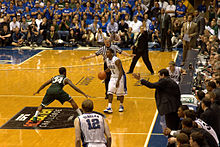 A Duke basketball game at Cameron Indoor Stadium
A Duke basketball game at Cameron Indoor Stadium
Collegiate athletics are a primary focus in Durham. Duke University's men's basketball team draws a large following, selling out every home game at Cameron Indoor Stadium in 2009.[14] The fans are known as the Cameron Crazies and are known nationwide for their chants and rowdiness. The team has won the NCAA Division I championship twice since 2001 and four times overall.[15] Duke competes in a total of 26 sports in the Atlantic Coast Conference.
North Carolina Central University's athletic program began to transition to Division I in 2005 and has begun competing in the Mid-Eastern Athletic Conference. NCCU has won CIAA championships in football, volleyball, and cross country for two consecutive years, in addition to the 1989 NCAA Division II Men's Basketball Championship.
Durham's professional sports team is the Durham Bulls International League baseball team. A movie involving the franchise, Bull Durham, was produced in 1988. The Bulls play in the Durham Bulls Athletic Park, on the southern end of downtown, constructed in 1994. Now with one of the newest stadiums in the minor leagues, the Bulls usually generate an annual attendance of around 500,000. Previously the Durham Athletic Park, located on the northern end of downtown, had served as the team's homebase. Historically, many Durham Bulls players have transferred to the big leagues after several years in the minor leagues. It has been preserved for the use of other minor league baseball teams as well as for concerts sponsored by the City of Durham and other events. The Durham Dragons, a women's fast pitch softball team, played in the Durham Athletic Park from 1998–2000. The DAP recently went through a $5 million renovation.
Media
The major daily newspaper in Durham is The Herald-Sun, which began publication in 1893. The Durham-based Independent Weekly, noted for its investigative journalism and progressive/liberal perspective, provides political and entertainment news for the greater Research Triangle; it began publication in 1983.
Durham is part of the Raleigh-Durham-Fayetteville Designated Market Area, the 27th largest broadcast television market in the United States. Eight television stations are licensed or have significant operations in Durham, including WTVD-TV based in downtown Durham. All major U.S. television networks have affiliates serving the region, with most of them based in the city.
Durham and a large part of the Triangle area is Arbitron radio market #43. Public television and radio are provided by WUNC, which is based in Chapel Hill and has significant operations in Durham.
Politics
The area is predominantly Democratic, and has voted for the Democratic Party's presidential candidate in every election since the city's founding in 1869. Durham is an activist community and politics are lively, visible, and often contentious,[citation needed] and like many communities, often dealing with issues of race and class.[citation needed] The shifting alliances of the area's political action committees since the 1980s has led to a very active local political scene. Notable groups include the Durham Committee on the Affairs of Black People, the Durham People's Alliance, and the Friends of Durham Friends of Durham. The first two groups tend to be affiliated with Democratic party activists, while the third group tends to attract Republican activists. Compared to other similarly sized Southern cities, Durham has a larger than average population of middle class African-Americans and white liberals.[citation needed] Working together in coalition, these two groups have dominated city and county politics since the early 1980s.
Durham operates under a council-manager government. The mayor since 2001 is Bill Bell, who was most recently reelected in 2011 with 82% of the vote in a runoff election[16]. The seven-member City Council is the primary budgetary and lawmaking authority.[17]
Key political issues have been the redevelopment of Downtown Durham and revival of other historic neighborhoods and commercial districts, a 45% reduction of crime, a 10 year plan to end homelessness, initiatives to reduce truancy, issues related growth and development. Naturally, a merger of Durham City Schools (several inner city neighborhoods) and Durham County Schools in the early 1990s has not been without controversy.
Federally, Durham is part of North Carolina's 4th congressional district, represented by Democrat David Price, elected in 1996.
Since 2003 the city has had a policy to prohibit police from inquiring into the citizenship status of persons unless they have otherwise been arrested or charged with a crime. A city council resolution mandates that police officers "...may not request specific documents for the sole purpose of determining a person's civil immigration status, and may not initiate police action based solely on a person's civil immigration status ..."[18] Since 2010, the Durham police have accepted the Mexican Consular Identification Card as a valid form of identification.[19]
In 2006, racial and community tensions stirred[20] following false allegations of a sexual assault by three white members of the Duke University lacrosse team in what is now known as the 2006 Duke University lacrosse case. The allegations were made by Crystal Gail Mangum a young African- American woman, student, stripper and mother of two young children. She and another young woman had been hired to dance at a party that the team held in an off-campus house. In 2007, all charges in the case were dropped and the players were declared innocent. Durham County District Attorney Mike Nifong was dismissed from his job and disbarred from legal practice for his criminal misconduct handling of the case including withholding of exculpatory evidence. There have been several other results from the case, including lawsuits against both city and Duke University officials.
Education
 Duke Chapel in West Durham.
Duke Chapel in West Durham.
Primary and secondary schools
Public schools in Durham are run by Durham Public Schools, the eighth largest school district in North Carolina. The district runs 46 public schools, consisting of 28 elementary, 8 middle, 2 secondary, and 7 high schools. Several high schools focus on distinct subject areas, such as the Durham School of the Arts and the City of Medicine Academy.[21] Public schools in Durham were partially segregated until 1970.
The North Carolina School for Science and Mathematics is a high school operated by the University of North Carolina in central Durham. The residential school accepts rising juniors with a focus on technology, science, medicine, and mathematics.
Several private schools also operate in Durham,[22] including Durham Academy and a number of religious schools.
In December 2007, Forbes.com ranked Durham as one of the "Top 20 Places to Educate Your Child;" Durham was the only MSA from North Carolina to make the list.[23][24]
Colleges and universities
Duke University is one of the premier universities in the United States and the world, with around 14,000 students split evenly between graduates and undergraduates.[25] Duke's 8,600 acres (35 km2) campus and Medical Center are located in western Durham, about 2 miles (3.2 km) from downtown. Duke forms one of the three vertices of the Research Triangle along with the University of North Carolina at Chapel Hill and North Carolina State University. The University's research, medical, and teaching efforts are all among the highest-ranked in both the United States and the world.
North Carolina Central University is a public, historically black university located in southeastern Durham. The University was founded in 1910 to address the needs of the region's black population, and now grants baccalaureate, master’s, professional and doctoral degrees. NCCU became a public University when it joined the University of North Carolina system in 1972. Durham Technical Community College is a two-year public institution that grants associates degrees.
Transportation
See also: Durham, North Carolina (Amtrak station)Most travel in Durham is by private vehicle on its network of public streets and highways. Important arteries for traffic include NC 147, which connects Duke University, downtown, and Research Triangle Park, U.S. 15-501 between Durham and Chapel Hill, I 85, connecting Durham to Virginia and western North Carolina cities, and I-40 running across southern Durham County between the Research Triangle Park and Chapel Hill. The I-40 corridor has been the main site of commercial and residential development in Durham since its opening in the early 1990s. Over 95% of commuters use a car to get to work, with 14% of those people in carpools.[26]
Durham maintains an extensive network of bicycle routes and trails and has been recognized with a Bicycle Friendly Community Award.[27] The American Tobacco Trail begins in downtown and continues south through Research Triangle Park and ends in Wake County. The city is also considering furthering the progress on the Triangle Greenway System.
Air travel is serviced by Raleigh-Durham International Airport, which enplanes about 4.5 million passengers per year.[28] Frequent service (5 flights a day or more) is available to Philadelphia, Atlanta, New York LaGuardia, New York Kennedy, Washington Reagan, Washington Dulles, Chicago O'Hare, Dallas, and Charlotte. Non-stop daily service is provided to approximately 30 destinations in the United States and daily international service is also available to London Heathrow, Toronto-Pearson and Cancún, Mexico.
Triangle Transit (known formerly as the Triangle Transit Authority, or TTA) offers scheduled, fixed-route regional and commuter bus service between Raleigh and the region's other principal cities of Durham, Cary and Chapel Hill, as well as to and from the Raleigh-Durham International Airport, Research Triangle Park and several of the region's larger suburban communities. TT also coordinates an extensive vanpool and rideshare program that serves the region's larger employers and commute destinations.
From 1995, the cornerstone of Triangle Transit's long-term plan was a 28-mile (45 km) rail corridor from northeast Raleigh, through downtown Raleigh, Cary, and Research Triangle Park, to Durham using DMU technology. There were proposals to extend this corridor 7 miles (11 km) to Chapel Hill with light rail technology. However, in 2006 Triangle Transit deferred implementation indefinitely when the Federal Transit Administration declined to fund the program. Government agencies throughout the Raleigh-Durham metropolitan area have struggled with determining the best means of providing fixed-rail transit service for the region.[citation needed]
The region's two metropolitan planning organizations appointed a group of local citizens in 2007 to reexamine options for future transit development in light of Triangle Transit's problems. The Special Transit Advisory Commission (STAC) retained many of the provisions of Triangle Transit's original plan, but recommended adding new bus services and raising additional revenues by adding a new local half-cent sales tax to fund the project.[29]
Duke University also maintains its own transit system, Duke Transit operates more than 30 buses with routes throughout the campus and health system. Duke campus buses and vans have alternate schedules or do not operate during breaks and holidays. A new Greyhound bus and amtrak station was built in 2011 in downtown Durham.
Geography
Durham is located in the east-central part of the Piedmont region at 35°59′19″N 78°54′26″W / 35.98861°N 78.90722°W (35.988644, −78.907167).[30] Like much of the region, its topography is generally flat with some rolling hills. The city has a total area of 94.9 square miles (245.8 km²), of which, 94.6 square miles (245.1 km²) of it is land and 0.3 square miles (0.7 km²) (0.29%) is water. The soil is predominantly clay, making it poor for agriculture. The Eno River passes through Durham, along with several other small creeks.
Climate
Durham is classified as a humid subtropical climate according to the Köppen classification, with warm and humid summers, cool winters, and mild spring and autumn. Durham receives abundant precipitation, with thunderstorms common in the summer. The region sees an average of 3.9 inches (99 mm) of snow per year, which usually melts within a few days.
Climate data for Durham Month Jan Feb Mar Apr May Jun Jul Aug Sep Oct Nov Dec Year Average high °F (°C) 49.6
(9.8)53.4
(11.9)62.1
(16.7)72.1
(22.3)79.0
(26.1)85.4
(29.7)89.2
(31.8)88.0
(31.1)81.6
(27.6)71.7
(22.1)62.8
(17.1)53.2
(11.8)70.7 Average low °F (°C) 27.5
(−2.5)28.6
(−1.9)36.2
(2.3)44.5
(6.9)53.4
(11.9)62.8
(17.1)67.0
(19.4)65.7
(18.7)59.0
(15.0)45.3
(7.4)36.9
(2.7)30.7
(−0.7)46.5 Precipitation inches (mm) 4.43
(112.5)3.70
(94)4.68
(118.9)3.40
(86.4)4.58
(116.3)4.00
(101.6)4.01
(101.9)4.38
(111.3)4.35
(110.5)3.71
(94.2)3.38
(85.9)3.43
(87.1)48.06
(1,220.7)Snowfall inches (cm) 1.1
(2.8)1.5
(3.8)0.9
(2.3)0
(0)0
(0)0
(0)0
(0)0
(0)0
(0)0
(0)0.1
(0.3)0.3
(0.8)3.9
(9.9)Avg. precipitation days (≥ 0.01 in) 10.9 9.5 11.0 8.9 10.5 8.9 9.5 9.1 7.7 6.9 8.1 9.9 110.9 Source: NOAA [31] Demographics
Historical populations Census Pop. %± 1890 5,485 — 1900 6,679 21.8% 1910 18,241 173.1% 1920 21,719 19.1% 1930 52,037 139.6% 1940 60,195 15.7% 1950 73,368 21.9% 1960 84,642 15.4% 1970 100,768 19.1% 1980 100,831 0.1% 1990 136,611 35.5% 2000 187,035 36.9% 2010 228,330 22.1% As of the 2000 census[4], there were 187,035 people, 74,981 households, and 43,563 families residing in the city. The population density was 1,976.4 people per square mile (763.1/km²). There were 80,797 housing units at an average density of 853.8 per square mile (329.7/km²). The racial composition of the city was: 45.50% White, 43.81% Black or African American, 3.64% Asian American, 0.31% Native American, 0.04% Native Hawaiian or Other Pacific Islander, 4.75% some other race, and 1.94% two or more races. 8.56% were Hispanic or Latino of any race.
There were 74,981 households out of which 28.7% had children under the age of 18 living with them, 38.2% were married couples living together, 15.9% had a female householder with no husband present, and 41.9% were non-families. 31.9% of all households were made up of individuals and 7.2% had someone living alone who was 65 years of age or older. The average household size was 2.37, and the average family size was 3.01.
In the city the population was spread out with 22.9% under the age of 18, 14.1% from 18 to 24, 35.6% from 25 to 44, 18.1% from 45 to 64, and 9.3% who were 65 years of age or older. The median age was 31 years. For every 100 females there were 92.5 males. For every 100 females age 18 and over, there were 89.1 males.
The median income for a household in the city was $41,160, and the median income for a family was $51,162. Males had a median income of $35,202 versus $30,359 for females. The per capita income for the city was $22,526. About 11.3% of families and 15.0% of the population were below the poverty line, including 19.4% of those under age 18 and 13.2% of those age 65 or over.
Tallest buildings
Rank Name Height
ft / mFloors Year Notes 1 University Tower 356 17 1990's Tallest building in Durham. 2 Durham Centre 300 18 Home of the Durham Chamber of Commerce. Twin building is planned. 3 North Carolina Mutual Building 250 14 Former headquarters of N.C Mutual Life. 4 The Hill Building 207 17 Is currently being turned into a hotel 5 Duke Chapel 202 6 Quintiles 200 11 Headquarters for Quintiles 7 Hock Plaza 200 11 8 Durham County Courthouse 187 11 2011/2012 Under construction. Expected to be completed in late 2011 or early 2012. Notable people
Born in Durham
- The Late Show with David Letterman comedian and television personality Biff Henderson
- Vogue Editor & Fashion Luminary/Current Judge of ANTM Andre Leon Talley
- Artist/painter Ernie Barnes
- Pastor & Gospel recording artist Shirley Caesar
- Pastor & Gospel recording artist John P. Kee
- Major League Soccer defender Ike Opara of the San Jose Earthquakes
- Major league baseball pitcher Roger Lee Craig[32]
- David Gergen, advisor to presidents Ford, Reagan, and Clinton
- Brittany Hargest and Brandon Hargest, Singers for Jump5
- Comic actor and novelty musician Pigmeat Markham.
- Contemporary Jazz musician LeRoi Moore of the Dave Matthews Band.
- Songwriter John D. Loudermilk ("Tobacco Road", "Then You Can Tell Me Goodbye")
- New York Times Theater Critic Ben Brantley
- John Lucas II, NBA player and coach
- Singer/songwriter Clyde McPhatter
- Actress Anita Morris
- Blues Musician Bull City Red
- David Noel, NBA player for the Milwaukee Bucks[33]
- Songwriter Don Schlitz (Kenny Rogers's "The Gambler")
- Hip-Hop Artist/producer 9th Wonder
- Hip-Hop Group Little Brother
- Hall of Fame baseball player Rick Ferrell[34]
- NFL (2002–Present) quarterback, Free Agent David Garrard
- John H. Hager, former Virginia Lieutenant Governor (1998–2002) and the father-in-law of former First Daughter Jenna Bush Hager
- NBA (1993–2005) power forward Rodney Rogers
- Current major league baseball player Brian Roberts, second baseman for the Baltimore Orioles[35]]
- Former Undersecretary of the Treasury Robert K. Steel
- NFL (1994–2005) cornerback Dewayne Washington
- Olympic champion snowboarder Seth Wescott[36]
- Major League Baseball first baseman Josh Whitesell of the Arizona Diamondbacks
Residents of Durham
- Singer/actor Clay Aiken. Born in neighboring Raleigh, but a current resident of Durham.
- Branford Marsalis has been a resident of Durham for several years. The Branford Marsalis Quartet's 2006 album Braggtown was titled after Braggtown Baptist Church, which sits in the neighborhood of Bragtown, located in northeastern Durham, just north of Highways 70/85.[37]
- The Mountain Goats, an indie rock band.
- Jamie Stewart, Frontman of experimental music group Xiu Xiu & member of Former Ghosts.
- Dr. LeRoy T. Walker, former United States Olympic President and former Chancellor of North Carolina Central University(NCCU), presently lives in Durham.[38]
- Mur Lafferty, podcaster and writer.
- Nnenna Freelon, jazz singer.
- Mike Nifong, disbarred District Attorney.
- R. Kelly Bryant, Jr., Activist, Historian, Leader.[39]
- Michelle Gordon, national and international award-winning martial artist.
- Big Daddy Kane, Hip-hop artist and actor.[40]
Associated with Durham
- Blind Boy Fuller, Musician.
- Rev. Gary Davis, Musician.
- Andrew Britton, Novelist.
- Pulitzer Prize-winning cartoonist Doug Marlette lived in Durham as a child.[41]
See also
References
- ^ "About Durham". http://www.durhamnc.gov/about/. Retrieved October 9, 2009.
- ^ a b c "Subcounty population estimates: North Carolina 2000–2006" (CSV). United States Census Bureau, Population Division. June 28, 2007. http://www.census.gov/popest/cities/files/SUB-EST2006_37.csv. Retrieved May 28, 2008.
- ^ a b Durham (N.C.) – Directories. Richmond, Virginia: Hill Directory Company. 1923. p. 7. http://www.archive.org/stream/hilldirectorycos1923hill/. Retrieved May 13, 2010.
- ^ a b "American FactFinder". United States Census Bureau. http://factfinder.census.gov. Retrieved 2008-01-31.
- ^ "US Board on Geographic Names". United States Geological Survey. 2007-10-25. http://geonames.usgs.gov. Retrieved 2008-01-31.
- ^ "Find a County". National Association of Counties. http://www.naco.org/Counties/Pages/FindACounty.aspx. Retrieved 2011-06-07.
- ^ "Where is RTP?". Research Triangle Foundation of North Carolina. http://www.rtp.org/main/index.php?pid=184&sec=1. Retrieved October 9, 2007 It says from The Herald Sun, that it's the 4th smartest city in the USA..
- ^ History | Carolina Theatre
- ^ "NC Finally Recognizes Pre-Woolworth Sit-Ins In 1956". Greensboro Telegram. January 19, 2008. http://www.greensboro3.com/default.asp?sourceid=&smenu=1&twindow=&mad=&sdetail=1495&wpage=1&skeyword=&sidate=&ccat=&ccatm=&restate=&restatus=&reoption=&retype=&repmin=&repmax=&rebed=&rebath=&subname=&pform=&sc=2762&hn=greensboro3&he=.com.
- ^ "Dedication of the 1957 Royal Ice Cream sit-in historical marker". Terra Sigillata. November 29, 2009. http://scienceblogs.com/terrasig/2009/11/dedication_of_1957_royal_ice_c.php. Retrieved May 13, 2010.
- ^ "G-123 Royal Ice Cream Sit-In". North Carolina Highway Historical Marker Program. http://www.ncmarkers.com/Markers.aspx?ct=ddl&sp=search&k=Markers&sv=G-123%20-%20ROYAL%20ICE%20CREAM%20SIT-IN. Retrieved May 13, 2010.
- ^ St. Joseph's Historical Foundation at Hayti Heritage Center.
- ^ Durham History.
- ^ Headlines: Men's Basketball Attendance Ranked 99th Nationally - BC Interruption
- ^ NCAA College Basketball Tournament Winners and Final Four Teams
- ^ [1]
- ^ Durham, NC - City of Medicine
- ^ Matt Dies, "Durham may tweak checks for immigrants," "News and Observer" September 6, 2007 http://www.newsobserver.com/news/story/694361.html
- ^ Durham tells police to accept Mexican ID "WTVD-TV Raleigh-Durham, NC" November 16, 2010 http://abclocal.go.com/wtvd/story?section=news/local&id=7791569l
- ^ Yardley, William (May 3, 2006). "Prosecutor in Duke Case Wins Election". The New York Times. http://www.nytimes.com/2006/05/03/us/03durham.html. Retrieved May 1, 2010.
- ^ "City of Medicine Academy"
- ^ Retrieved May 9, 2011.
- ^ In Pictures: Top 20 Places To Educate Your Child. Retrieved December 26, 2007.
- ^ "Where To Educate Your Children". Retrieved December 26, 2007.
- ^ Retrieved May 9, 2011
- ^ Work and Jobs in Durham, North Carolina (NC) Detailed Stats: Occupations, Industries, Unemployment, Workers, Commute
- ^ The Herald-Sun - Cycling group Durham Bicycle Friendly
- ^ Raleigh-Durham International Airport in Durham, North Carolina - Elevation, Runways, Altitude
- ^ Regional Transit Infrastructure Blueprint
- ^ "US Gazetteer files: 2010, 2000, and 1990". United States Census Bureau. 2011-02-12. http://www.census.gov/geo/www/gazetteer/gazette.html. Retrieved 2011-04-23.
- ^ "NOW Data-NOAA Online Weather Data". National Oceanic and Atmospheric Administration. 2011. http://www.weather.gov/climate/xmacis.php?wfo=rah. Retrieved January 2, 2011.
- ^ "Roger Lee Craig". Baseball Almanac. http://www.baseball-almanac.com/players/player.php?p=craigro01. Retrieved July 16, 2007.
- ^ David Noel
- ^ "Rick Ferrell". The Baseball Page. http://www.thebaseballpage.com/players/ferreri01.php. Retrieved July 16, 2007.
- ^ "Brian Roberts Statistics". Sports Reference, Inc.. http://www.baseball-reference.com/r/roberbr01.shtml. Retrieved July 29, 2007.
- ^ "Rick Ferrell". United States Olympic Committee. Archived from the original on July 14, 2007. http://web.archive.org/web/20070714104047/http://www.usoc.org/26_38187.htm. Retrieved July 16, 2007.
- ^ "Branford's bragging rights". News and Observer. Archived from the original on May 22, 2008. http://web.archive.org/web/20080522005306/http://www.newsobserver.com/105/story/485019.html. Retrieved October 24, 2007.
- ^ "LeRoy Walker Bio". US Track and Field Hall of Fame. http://www.usatf.org/HallOfFame/TF/showBio.asp?HOFIDs=176. Retrieved October 24, 2007.
- ^ Kelly Bryant's Bio | url=http://www.duke.edu/web/hst195.15/person1/
- ^ "Big Daddy Kane, The Jay-Z Of '89, Still Every Bit The Playa". MTV News. http://www.mtv.com/news/articles/1455072/big-daddy-kane-still-playa.jhtml. Retrieved 7 September 2011.
- ^ "Cartoonist Doug Marlette dies in wreck". Raleigh News and Observer. Archived from the original on July 13, 2007. http://web.archive.org/web/20070713131622/http://www.newsobserver.com/105/story/632517.html. Retrieved July 16, 2007.
External links
- Government & Commerce
- History
- Digital Durham Exploring and chronicling the history of post-Civil War Durham
- Endangered Durham Website with history and many before-and-after pictures of architecture in Durham
- North Carolina Room of the Durham County Library Website for an archive which collects materials concerning the city and county of Durham
- Review of Southern Mill Village: History of Old West Durham on Teachinghistory.org
- Arts, Entertainment and Local Media
- The Herald Sun
- Durham Arts Council
- Durham Association for Downtown Arts (DADA)
- Durham Socialite Durham's source for social events.
- Sojam Festival Weekend-long a cappella extravaganza in Durham
- Troika Music Festival
- Full Frame Documentary Film Festival
- WXDU 88.7 FM
- The World Music Central guide to Durham For cultural travelers interested in local roots music, venues, CD shops, instrument makers, etc.
- Taste of Durham Annual food and live music festival.
- Durham Skywriter Durham Skywriter local news
- Festival for the Eno Website Annual festival for ENO river conservation
Municipalities and communities of Durham County, North Carolina County seat: DurhamCities Durham‡ | Raleigh‡
Towns CDP Unincorporated
communitiesTownships Footnotes ‡This populated place also has portions in an adjacent county or counties
Municipalities and communities of Orange County, North Carolina Cities Durham‡ | Mebane‡
Towns Unincorporated
communitiesBlackwood | Buckhorn | Caldwell | Calvander | Carr | Cedar Grove | Dogwood Acres | Efland | Eno | Eubanks | Hurdle Mills | McDade | Miles | Oaks | Rougemont | Schley | Teer | University
Footnotes ‡This populated place also has portions in an adjacent county or counties
Municipalities and communities of Wake County, North Carolina Cities Durham‡ | Raleigh‡
Towns Apex | Cary‡ | Clayton‡ | Fuquay-Varina | Garner | Holly Springs | Knightdale | Morrisville‡ | Rolesville | Wake Forest‡ | Wendell | Zebulon‡
Townships Bartons Creek | Buckhorn | Cary | Cedar Fork | Holly Springs | House Creek | Leesville | Little River | Marks Creek | Meredith | Middle Creek | Neuse | New Light | Panther Branch | Raleigh | St. Mary's | St. Matthew's | Swift Creek | Wake Forest | White Oak
Unincorporated
communitiesAuburn | Bonsal | Carpenter | Chestnut Hills | Clegg | Eagle Rock | Falls | Feltonville | Forestville | Friendship | Green Level | Holland | Hopkins | Kennebec | Lizard Lick | McCullers Crossroads | Neuse | New Hill | Riley Hill | Shotwell | Stony Hill | Swift Creek | Willow Spring
Footnotes ‡This populated place also has portions in an adjacent county or counties
Greater Durham-Chapel Hill Metropolitan Region (Durham MSA) Principal cities Durham • Chapel Hill
Other significant cities Counties Major universities Transportation Raleigh-Durham International Airport • I-40 • I-85 • I-540 • US 15-501 • US 64 • US 70 • NC 147 • NC 54Media The Herald-Sun • The Daily Tar Heel • Independent Weekly • The News & Observer • Carrboro Citizen • The Courier TimesMiscellaneous - Anthony Foxx
(Charlotte)
- Bill Knight
(Greensboro)
- Bill Bell
(Durham)
- Anthony G. Chavonne
(Fayetteville)
- Rebecca Smothers
(High Point)
 State capital: Raleigh
State capital: Raleigh
Other states: AL • AK • AZ • AR • CA • CO • CT • DE • FL • GA • HI • ID • IL • IN • IA • KS • KY • LA • ME • MD • MA • MI • MN • MS • MO • MT • NE • NV • NH • NJ • NM • NY • NC • ND • OH • OK • OR • PA • RI • SC • SD • TN • TX • UT • VT • VA • WA • WV • WI • WYCategories:- Durham, North Carolina
- Populated places established in 1853
- Cities in North Carolina
- Duke family
- Research Triangle, North Carolina
- University towns in the United States
- County seats in North Carolina
- Planned cities in the United States
Wikimedia Foundation. 2010.

